Illumination: Lighting up the Toronto sign
by all | 27 October 2015 10:27 am
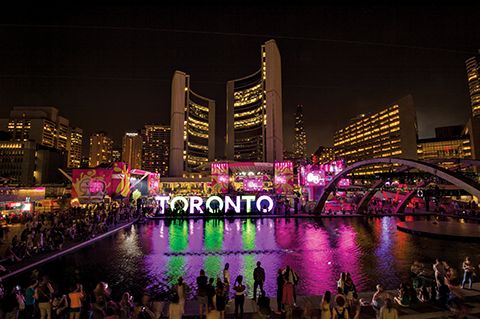 [1]
[1]Photo courtesy City of Toronto
By Peter Saunders
In mid-September, Toronto Mayor John Tory announced the city’s new—but already iconic—multicoloured illuminated channel letter sign, on display in Nathan Phillips Square in front of City Hall since July, would remain in place until at least the end of 2016. This decision would of course be less expensive than transporting the sign to other locations throughout the city, as had been discussed, but at the same time recognized how popular the sign has become, particularly in turning visitors’ photos of City Hall into virtual postcards promoting the city.
International inspiration
The sign was originally planned to serve only as a temporary public-art structure during the 2015 Pan Am and Parapan Am Games. And it was just one of four elements in the city’s ‘welcome and engagement’ campaign, the others being a giant ferry wrap, a street banner program and a series of out-of-home (OOH) sculptures and posters featuring the multi-sport competition’s mascot, Pachi the porcupine[2].
Indeed, when municipal government employees came up with the concept of spelling out the city’s name in oversized letters in a public space, they were inspired by other event-related ‘photo opp’ branding installations around the world, especially one set up in Guadalajara, Mexico, for the previous Pan Am Games in 2011, but also Vancouver’s giant rings during the 2010 Winter Olympic Games.
The city staff issued a request for proposals (RFP), specifying three-dimensional (3-D) letters in Azo Sans Bold font, each measuring about 3 x 3 m (10 x 10 ft), for a total sign area of 3 x 22 m (10 x 72 ft). They would be equipped with light-emitting diodes (LEDs) for the purpose of changing colours.
Staging the structure
The winning bid came from Unit 11, a local business perhaps best-known for building the current Hockey Night in Canada (HNIC) set for Rogers Communications.
“We’re not a sign company, but this project was a good fit because we build a lot of large structures full of LEDs,” explains Don Loughlin, Unit 11’s president. “We were also already doing other Pan Am-related work at the time.”
Working collaboratively with the city based on the given specifications, Unit 11 provided further designs and drawings. Of the three weeks available for the project, one full week was dedicated to production, which primarily involved computer numerical control (CNC) routing and welding.
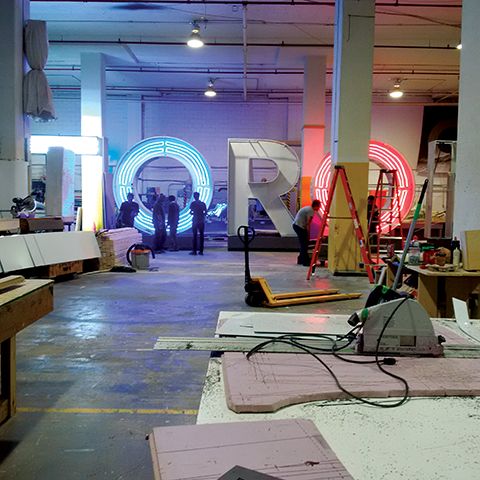 [3]
[3]Tad Lighting Services worked in parallel with Unit 11 to customize the sign’s LED configuration. Photos courtesy Unit 11
“The construction was fairly straightforward, but the size was a challenge,” says Loughlin. “It’s a very big sign. It took up our whole shop.”
One new challenge for the company, given its previous focus on indoor sets, was ensuring the letters would stand up to the outdoor environment. The letters were built with a steel frame, aluminum panel cladding and translucent polycarbonate front and rear faces.
“The city wanted to make sure it would last up to three years,” says Loughlin. “We sprayed the steel frame to rustproof it. The polycarbonate material is tough as it gets; water can’t get in and you can’t break it. We even put bird repellant on at the end!”
The letters also featured colourful vinyl side wraps with Pan Am logos. These were designed to be removed after the games, so the letters can be ‘re-skinned’ with different designs in the future.
Lighting the letters
For illumination, Unit 11 turned to the LED design division of Tad Lighting Services, with which it has worked on many past projects, including the HNIC set.
“It’s been a marriage made in heaven,” says Adrian Goldberg, Tad’s president. “It’s a joy to work with Unit 11 because we each understand what the other needs.”
“Everything you see on TV has LEDs in it now,” adds Loughlin.
Similar to the HNIC set, the challenge with the Toronto sign letters was to provide even illumination across all of the front and rear faces.
“We prepared rolls of LEDs while the letters were being put together in Unit 11’s shop, rather than afterwards,” says Goldberg. “This way, we could work in parallel to ensure the quality and evenness of the lighting. The LEDs needed to be installed with a clear line of sight to the polycarbonate faces of each letter.”
“We also made sure there was lots of air space to keep the LEDs cool, as the letters could heat up a bit in the summer sun,” says Loughlin.
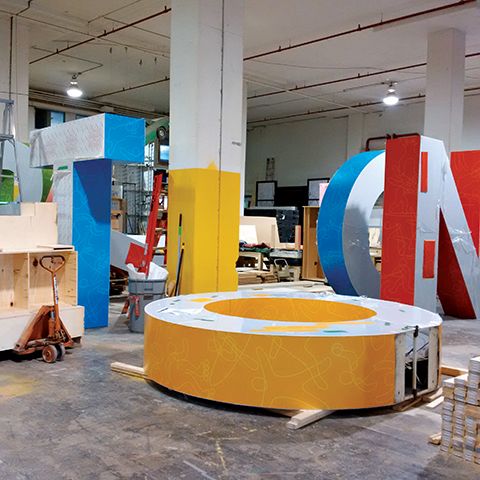 [4]
[4]The project took up Unit 11’s entire shop.
Another challenge was making the illumination of each letter individually addressable and controllable.
“Each letter has a box inside that is controllable from a lighting board or master computer, to provide the most flexibility,” Goldberg explains. “Using Digital Multiplex (DMX) encoders as the ‘brains’ of the system, the operator can adjust the lighting levels of red, green, blue and white (RGBW) LEDs to create any of 256 million colours.”
This was useful to the city, which planned to match the colours of the letters to the specific branding scheme of the Pan Am Games, as well as co-ordinating them with the lighting of City Hall and nightly fireworks above the square.
Put in their place
The sign was unveiled in early July. Unit 11’s team installed it along the northwest corner of Nathan Phillips Square’s reflecting pool, positioning it for photo opps with City Hall’s towers in the background and the letters’ own reflections in the water. An optimal vantage point for photographers south of the pool was even delineated with street decals, urging visitors to share their photos via social media with the hashtags #share3DTO (representing the 3-D nature of the Toronto sign structure) and #HostCity2015.
“It was hard to install it, because as soon as we started, everyone was crowding around to photograph it,” says Loughlin. “I got interviewed on the spot by a television network and a newspaper! It was four days before the opening ceremonies and no one outside City Hall really knew the sign would be there.”
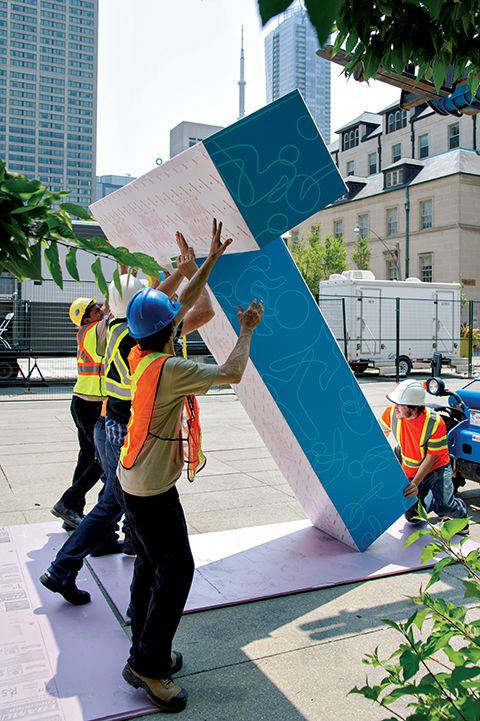 [5]
[5]While the letters are highly durable, they had to be handled carefully during installation, as some of their surfaces are thin.
Each letter weighs about 136 kg (300 lb) and sits upon a 1,180-kg (2,600-lb) plinth (i.e. base), for a total sign weight of 9,207 kg (20,300 lb). Despite this and the outdoor-ready materials, however, Unit 11 had to handle the letters with care during the on-site installation.
“If they didn’t light up, it might be a no-brainer,” says Loughlin, “but because of the thin material that enables a bright, even glow, you have to be careful. We couldn’t have amateurs installing these.”
The LEDs also necessitated some changes at the last minute.
“The plan was to control the illumination of each letter wirelessly, but as it turned out, there was too much signal interference in the area,” says Goldberg. “Given we had to run power to each letter anyway, we simply added Ethernet cabling between them, all the way down the line, with the last cable going to the control system.”
“You could also store a data sequence with a ‘colour queue’ in each letter and unplug it, but this way, there would be ‘live’ control,” says Loughlin.
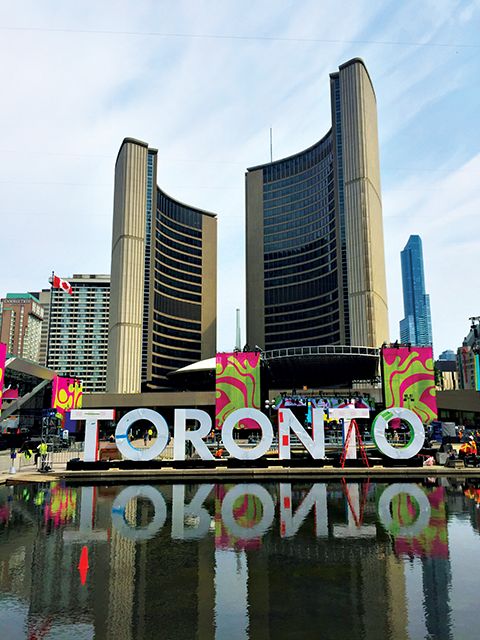 [6]
[6]Photos courtesy City of Toronto
A longer lifespan
As mentioned, while the sign was made with durability in mind, it was also originally intended only for temporary display. Since then, its popularity has led to it being seen as more of a permanent fixture.
“During the Pan Am Games, the lighting was controlled from the same system as the stage lighting for the square’s Panamania concerts,” says Goldberg. “Now it’s on a timer that cycles through preset colour changes 24-7. It could also be joined with the building lighting system for City Hall. I suspect the city wants to maintain it because it’s become bigger than anyone expected. It was part of the joy of the games. I think a lot of people were prepared to see the games fail, so their success was all the more amazing. Panamania, especially, was well-planned and it gave the city a lot of pride to see the square become so central to the games.”
Unit 11 has an ongoing maintenance contract with the city. Loughlin explains his team has had to clean and spruce up the letters, as people climb all over them, but he doesn’t worry too much about maintaining durability for the letters’ estimated lifespan of three to five years—or beyond.
“There was a big windstorm that didn’t blow them over,” he notes. “People can sit in the Os, as they’re specially reinforced. Winter could be interesting, but we’ll take out the wood in the letter bases and replace it with plastic. I’m confident the sign will last.”
With files from Toronto, Unit 11 and Tad Lighting. For more information, visit www.toronto.ca[7], www.unit11.com[8] and www.tadlighting.ca[9].
- [Image]: http://www.signmedia.ca/wp-content/uploads/2015/10/torontosign10.jpg
- Pachi the porcupine: http://www.signmedia.ca/dressing-up-toronto-for-the-pan-am-games/
- [Image]: http://www.signmedia.ca/wp-content/uploads/2015/10/IMG_20150702_163031.jpg
- [Image]: http://www.signmedia.ca/wp-content/uploads/2015/10/IMG_20150706_074707.jpg
- [Image]: http://www.signmedia.ca/wp-content/uploads/2015/10/torontosign7.jpg
- [Image]: http://www.signmedia.ca/wp-content/uploads/2015/10/torontosign9.jpg
- www.toronto.ca: http://www.toronto.ca
- www.unit11.com: http://www.unit11.com
- www.tadlighting.ca: http://www.tadlighting.ca
Source URL: https://www.signmedia.ca/illumination-lighting-up-the-toronto-sign/